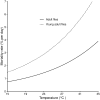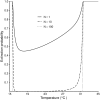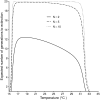Extinction probabilities as a function of temperature for populations of tsetse (Glossina spp.)
- PMID: 32379749
- PMCID: PMC7237048
- DOI: 10.1371/journal.pntd.0007769
Extinction probabilities as a function of temperature for populations of tsetse (Glossina spp.)
Abstract
Significant reductions in populations of tsetse (Glossina spp) in parts of Zimbabwe have been attributed to increases in temperature over recent decades. Sustained increases in temperature might lead to local extinctions of tsetse populations. Extinction probabilities for tsetse populations have not so far been estimated as a function of temperature. We develop a time-homogeneous branching process model for situations where tsetse live at different levels of fixed temperature. We derive a probability distribution pk(T) for the number of female offspring an adult female tsetse is expected to produce in her lifetime, as a function of the fixed temperature at which she is living. We show that pk(T) can be expressed as a geometric series: its generating function is therefore a fractional linear type. We obtain expressions for the extinction probability, reproduction number, time to extinction and growth rates. The results are valid for all tsetse, but detailed effects of temperature will vary between species. No G. m. morsitans population can escape extinction if subjected, for extended periods, to temperatures outside the range 16°C-32°C. Extinction probability increases more rapidly as temperatures approach and exceed the upper and lower limits. If the number of females is large enough, the population can still survive even at high temperatures (28°C-31°C). Small decreases or increases in constant temperature in the neighbourhoods of 16°C and 31°C, respectively, can drive tsetse populations to extinction. Further study is needed to estimate extinction probabilities for tsetse populations in field situations where temperatures vary continuously.
Conflict of interest statement
The authors have declared that no competing interests exist.
Figures







References
-
- Vale GA. Artificial Refuges for tsetse flies (Glossina spp.). Bull Entomol Res. 1971;61:331–350. 10.1017/S0007485300057874 - DOI
-
- Phelps RJ, Clarke GPY. Seasonal elimination of some size classes in males of Glossina morsitans morsitans Westw. (Diptera, Glossinidae). Bull Entomol Res. 1974;64(2):313–24. 10.1017/S0007485300031205 - DOI
Publication types
MeSH terms
Grants and funding
LinkOut - more resources
Full Text Sources
Miscellaneous

